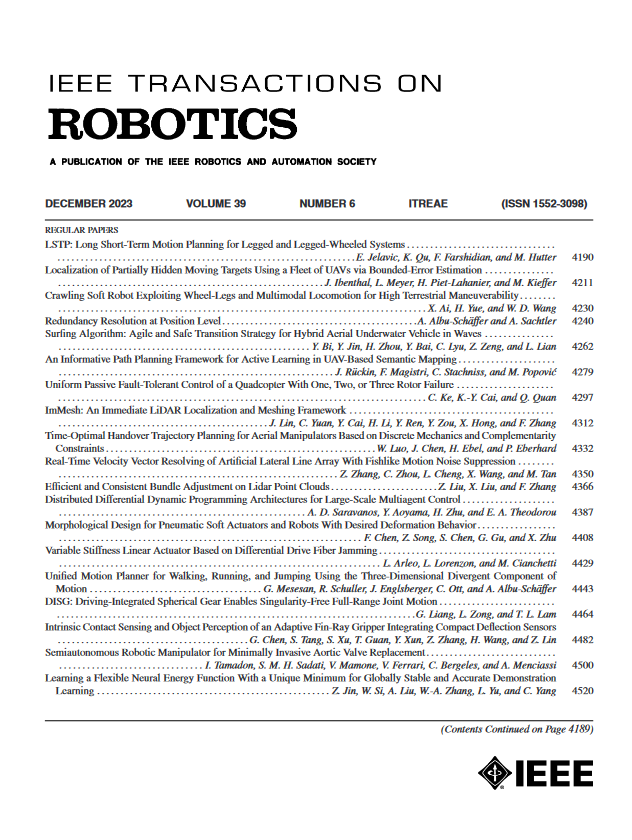Autonomous Tomato Harvesting With Top–Down Fusion Network for Limited Data
IF 9.4
1区 计算机科学
Q1 ROBOTICS
引用次数: 0
Abstract
Using robots for tomato truss harvesting represents a promising approach to agricultural production. However, incomplete acquisition of perception information and clumsy operations often results in low harvest success rates or crop damage. To addressthis issue, we designed a new method for tomato truss perception, an autonomous harvesting method, and a novel circular rotary cutting end-effector. The robot performs object detection and keypoint detection on tomato trusses using the proposed top–down fusion network, making decisions on suitable targets for harvesting based on phenotyping and pose estimation. The designed end-effector moves gradually from the bottom up to wrap around the tomato truss, cutting the peduncle to complete the harvest. Experiments conducted in real-world scenarios for robotic perception and autonomous harvesting of tomato trusses show that the proposed method increases accuracy by up to 11.42% and 22.29% for complete and limited dataset conditions, compared to baseline models. Furthermore, we have implemented an automatic tomato harvesting system based on TDFNet, which reaches an average harvest success rate of 89.58% in the greenhouse.基于自顶向下融合网络的有限数据番茄自主收获
使用机器人进行番茄桁架收获代表了一种很有前途的农业生产方法。然而,感知信息获取不完整和操作笨拙往往导致收获成功率低或作物受损。为了解决这一问题,我们设计了一种新的番茄桁架感知方法、一种自主收获方法和一种新型的圆形旋转切割末端执行器。机器人利用所提出的自顶向下融合网络对番茄桁架进行目标检测和关键点检测,基于表型和姿态估计来决定合适的收获目标。所设计的末端执行器从底部向上逐渐移动,缠绕在番茄桁架上,切断番茄梗,完成收获。在机器人感知和自主收获番茄桁架的真实场景中进行的实验表明,与基线模型相比,该方法在完整和有限数据集条件下的准确率分别提高了11.42%和22.29%。此外,我们还实现了基于TDFNet的番茄自动收获系统,该系统在温室内平均收获成功率达到89.58%。
本文章由计算机程序翻译,如有差异,请以英文原文为准。
求助全文
约1分钟内获得全文
求助全文
来源期刊

IEEE Transactions on Robotics
工程技术-机器人学
CiteScore
14.90
自引率
5.10%
发文量
259
审稿时长
6.0 months
期刊介绍:
The IEEE Transactions on Robotics (T-RO) is dedicated to publishing fundamental papers covering all facets of robotics, drawing on interdisciplinary approaches from computer science, control systems, electrical engineering, mathematics, mechanical engineering, and beyond. From industrial applications to service and personal assistants, surgical operations to space, underwater, and remote exploration, robots and intelligent machines play pivotal roles across various domains, including entertainment, safety, search and rescue, military applications, agriculture, and intelligent vehicles.
Special emphasis is placed on intelligent machines and systems designed for unstructured environments, where a significant portion of the environment remains unknown and beyond direct sensing or control.
 求助内容:
求助内容: 应助结果提醒方式:
应助结果提醒方式:


